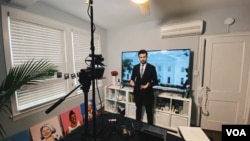As the coronavirus (COVID-19) pandemic engulfed the globe, Voice of America journalists embraced the challenge of not only covering the ever-evolving situation for their audiences around the world, but also doing it under unconventional circumstances, observing physical distancing and working in makeshift home studios.
VOA’s global audience was looking for a balanced, authoritative source of news and information amid the chaos. Across all of its websites, coronavirus-related coverage by VOA drove a new monthly traffic record in March, shattering the previous high of January. Also:
- There were more than 268 million video views across the four major social media platforms since January;
- Facebook posts generated more than 2.9 million engagement actions and nearly 29.1 million video views in the week as March turned to April ;
- VOA Coronavirus videos on YouTube received 8.7 million views that week, a 61% increase from the previous week.
- Engagement on Twitter and Instagram continued to climb, topping 2.2 million on Instagram-alone since January.
As the number of COVID-19 cases started declining in China, the Chinese government began changing the narrative about the pandemic and mounted a campaign questioning the origin of the virus while attempting to shift the blame to the U.S.
“It might be the U.S. Army who brought the epidemic to Wuhan,” said Chinese Foreign Ministry spokesperson Zhao Lijian in a tweet. “The U.S. owes us an explanation.” In response, the VOA Mandarin language service published an in-depth article on its website, debunking three false claims: that U.S. soldiers brought the virus to China; that the virus was developed by a U.S. Army medical research institute; and, that the mysterious lung disease associated with vaping was actually COVID-19.
The personal COVID-19 story of a VOA Indonesian reporter hit home with target audiences across the globe, generating impressive engagements on social media. The reporter documented his fear of contracting the virus at the Investigative Reporters and Editors conference in New Orleans in early March, after one of the attendees tested positive. In just hours, the video received more than one million views, more than 335,000 engagements on Facebook and nearly 270,000 views on Instagram, including 250,000 engagements.
The impact of the VOA Turkish service’s coverage has been growing. Its Twitter account experienced an unprecedented increase of 182% in impressions, pushing the number to 24 million impressions in a month. The profile visits increased by 327%, while mentions increased by 208% between February 20th and March 20th. In addition, the number of followers to the VOA Turkish Twitter account increased by 21% during the same month. VOA Turkish has also seen record increases in web traffic with total engaged minutes up by 97% and page views up by 83% in the last month.
VOA Deewa, broadcasting to the critical Pakistan/Afghanistan border region, launched a new podcast series on COVID-19 to create awareness about social distancing and answer questions on how to combat the virus.
VOA's Africa division engaged its audience with digital explainers, ask-the-doctor radio health segments, and video Public Service Announcements, debunking myths and misconceptions surrounding COVID-19.
“Self-medication is always a risky thing," Columbia University Epidemiologist Dr. Elizabeth Radin told VOA following coronavirus-related chloroquine poisonings in the United States, Nigeria, and Vietnam. "There are underlying conditions that could make the drug dangerous," she said. "There are possible interactions with other drugs you might be taking."
The TV show Straight Talk Africa produced a special edition on the pandemic, with two government officials, the head of pan-African disease agency and the leader of an academic research program.
When VOA Bosnian learned that a staff member’s family was sick, requiring the entire Bosnian team to work from home, within minutes, the service started producing television shows from home studios. Other VOA language services demonstrated their abilities to produce high quality programming from offsite locations included VOA Armenian’s engaging how-to video on how to create a home studio with a $1-green tablecloth, VOA Georgian’s live interactives from a basement studio, and VOA Albanian’s live interactive from a living room. VOA Russian remotely produced its Podrobno program about the spread of coronavirus in the U.S., becoming among the top-performing videos on YouTube. VOA Russian journalists engaged viewers with a live Talk Show From Home about spending time in quarantine. VOA Ukrainian's Facebook Live productions brought audience members interviews direct from the streets of Washington, Los Angeles, New York, London and Kyiv. VOA Serbian filmed a report in Bethesda, Maryland, on how Americans are coping with the pandemic and VOA Macedonian offered a story about mobile Red Cross teams helping the elderly. In total, the VOA Eurasia division's Coronavirus coverage garnered more than 4 million views on social media platforms.
When the Latin America division instructed its entire staff to telework fulltime, the Spanish and Creole services produced content for radio and television remotely, producing 80 to 105 live shots daily with affiliates from D.C., New York, Miami and L.A., including 20-25 packages daily for radio and television. As a result, the VOANoticias.com page views increased by 46% in the last week and a Facebook Live post on the closure of the Colombia-Venezuela border, reached 965,000 viewers, while a public service announcement on advice to be safe and healthy in New York had more than 89,000 views on Twitter.
Despite the challenges created by the pandemic in Iran, VOA Persian continued round-the-clock reporting on the COVID-19 pandemic on television, the web and social media platforms. Coverage included breaking news, extended editions, interactive programming and updates on the spread of the virus worldwide and particularly inside Iran.
As the COVID-19 pandemic continues to evolve globally, Voice of America anticipates increasing dependence on its coverage from its weekly global audience of more than 280 million.





